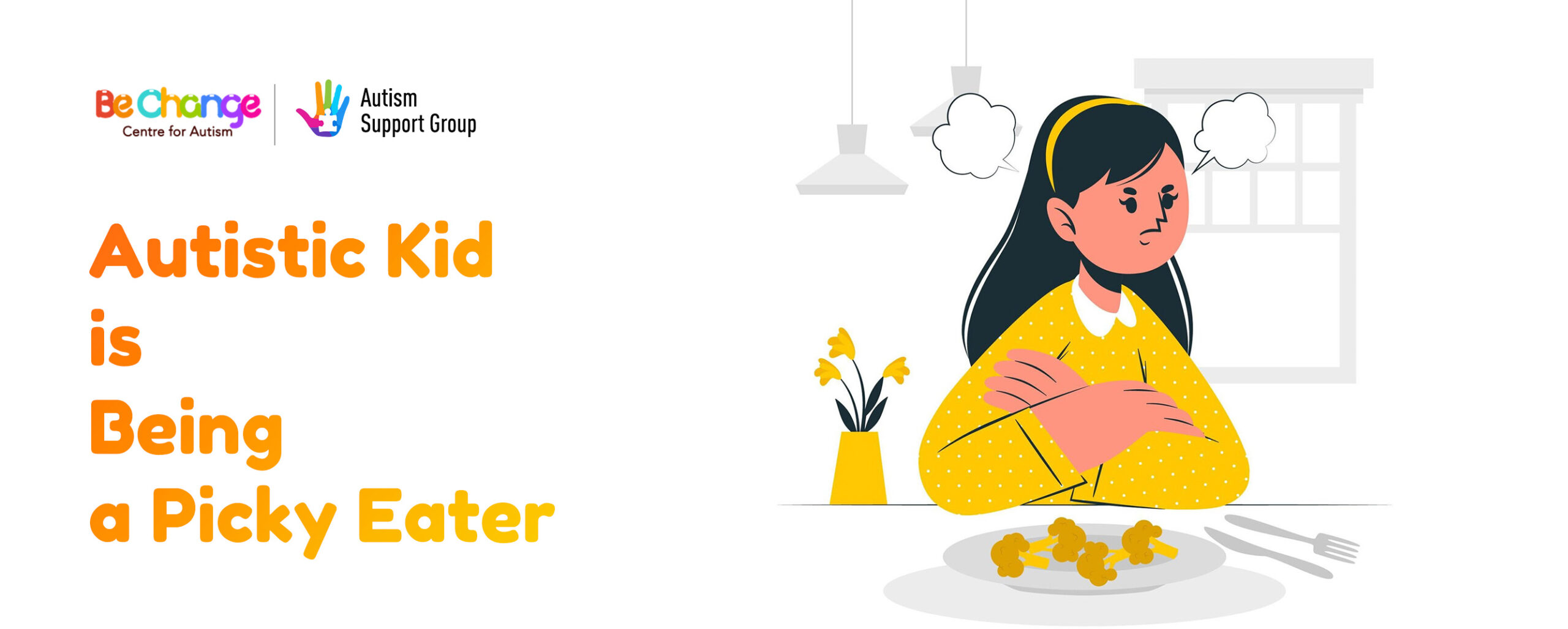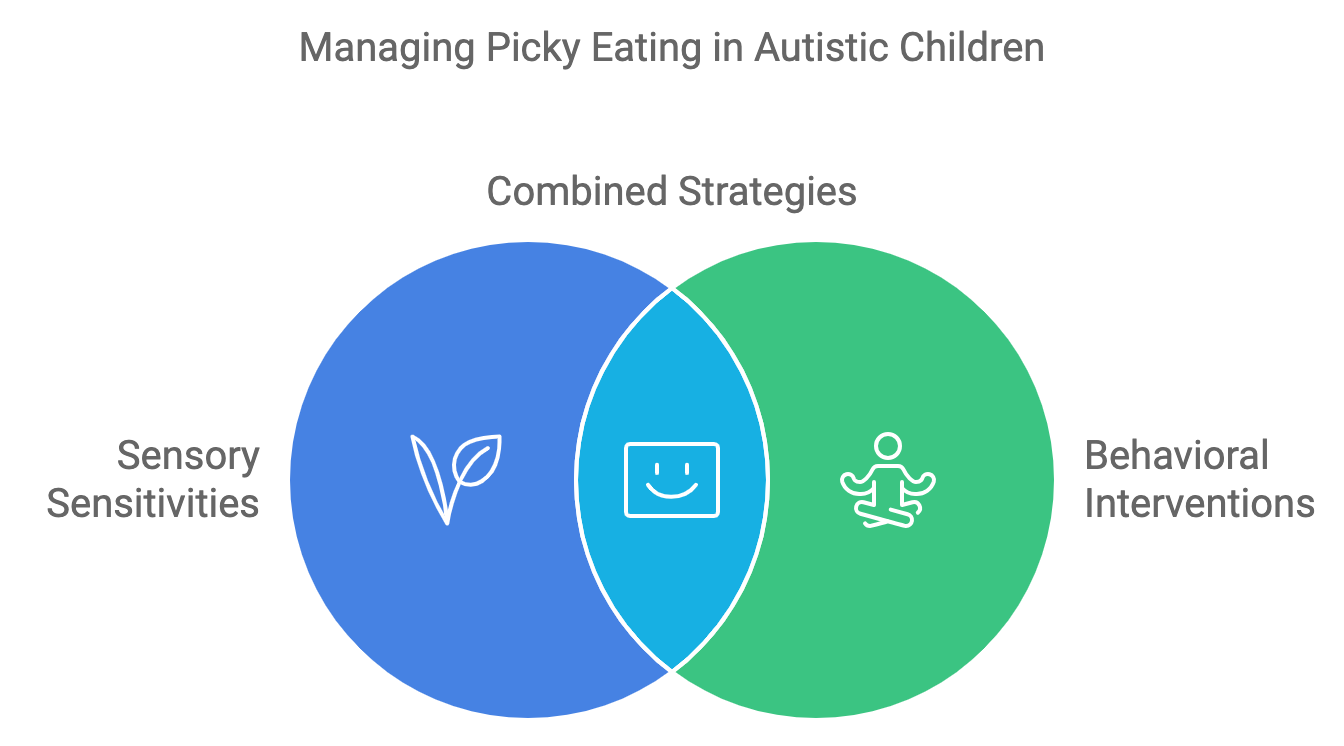
If you’re a parent to an autistic child, you’ve probably had your fair share of battles at the dinner table. For many autistic kids, eating isn’t just about food—it’s about managing overwhelming sensations, anxiety, and routines. In this guide, we’re going to explore why picky eating happens, how to handle it with empathy, and most importantly, practical tips you can use today to help your child expand their diet. Let’s get started!
Join Autism Support Community in Facebook
Understanding Your Autistic Child’s Picky Eating Habits
Before delving into solutions, it’s crucial to comprehend the underlying reasons. Picky eating is prevalent among autistic children and is often attributed to sensory sensitivities, adherence to routines, anxiety, or even medical issues.
Sensory Sensitivities: Beyond Taste Preferences
Contrary to popular belief, picky eating in autistic children extends beyond taste preferences. Sensory sensitivities play a pivotal role. Your child might find the texture of certain foods unbearable or be averse to the smell of specific dishes, leading them to avoid mealtimes altogether. It’s not merely a matter of being “picky”; these sensory experiences can be genuinely overwhelming.
Moreover, it’s not just about taste. Autistic children often exhibit heightened sensitivity to visual cues. The appearance and arrangement of food on their plate, as well as the color of the food, can trigger discomfort. One child might reject anything green, while another might insist on neatly portioned servings.
Routines and Rigidity
Autistic children often find comfort in routines, and mealtimes are no exception. The prospect of trying new foods can distress them if they are accustomed to a specific meal at a particular time. This resistance to change is not defiance; it’s their way of coping with their environment. Consistency brings them comfort.
Emotional Factors: Anxiety Surrounding Food
Put yourself in the shoes of a child asked to eat something with a peculiar smell, appearance, or uncomfortable texture. Now imagine being a child who might struggle to articulate that fear. Many autistic kids experience anxiety when confronted with new foods because it’s unfamiliar territory, and they are unsure of how their body will react.
Distinguishing Between Picky Eating and a Deeper Issue
As parents, it’s important to be able to tell the difference between typical picky eating and a more serious eating problem. How can you determine when it’s necessary to seek professional help for your child’s eating habits?
If your child is refusing entire food groups, consistently having meltdowns at mealtimes, or seems to be losing weight or missing key nutrients, it may be more than just a phase.
Look out for these red flags:
- Eating fewer than 10-15 different foods.
- Extreme aversions to textures or colors.
- Refusing foods across all categories (e.g., not eating fruits, vegetables, or proteins).
If you notice any of these signs, it might be time to consult a healthcare professional.
They can help determine whether it’s Avoidant/Restrictive Food Intake Disorder (ARFID) or related medical issues like gastrointestinal problems.
Sensory Sensitivities
Dealing with sensory sensitivities can be challenging, but there are effective strategies you can implement:
If your child struggles with certain textures, try serving foods in a form they’re more comfortable with. For instance, if they dislike mushy textures, roast vegetables to make them crispy instead of steaming them. If meat is too chewy, blend it into sauces or soups.
Gradually introducing new foods with similar textures to what your child already enjoys can also be helpful. Start with crunchy foods if they like that texture, then slowly move towards softer options.
Managing Smell Sensitivities
The smell can be a significant trigger for many children with sensory sensitivities. If certain foods have overpowering aromas, try serving them cold or at room temperature to minimize the smell. You can also experiment with using minimal seasoning to reduce strong odors.

Involving Your Child in Meal Preparation
Engaging your child in the cooking process can significantly reduce their anxiety around unfamiliar foods. When they help make the food, they get to interact with it in a low-pressure setting. This can instill a sense of control and gradually build their confidence with new foods.
Introduce New Foods Gradually: Offer small portions of a new food alongside something your child already enjoys. This approach prevents them from feeling overwhelmed by unfamiliar foods.
Avoid Pressure and Bribes: Refrain from using bribes like dessert in exchange for eating vegetables, as this tactic can have negative consequences. Instead, encourage your child to explore new foods without the expectation of finishing them. Simply touching or smelling a new food should be considered progress.
Shift the Focus Away from Eating: Make mealtimes a positive and social experience by discussing topics other than what your child is eating.
While sensory sensitivities play a significant role in picky eating, behavioral interventions can also be beneficial. Here are a few techniques to consider:
Cognitive-Behavioral Techniques: These methods are particularly effective for older children and teenagers. They help kids reframe their thoughts about food and recognize that trying new foods doesn’t have to be daunting. Programs like BUFFET (Building Up Food Flexibility and Exposure Treatment) focus on gradually introducing new foods in a structured, low-pressure manner. You can implement this at home by encouraging small, manageable challenges, such as trying a tiny bite of something new without any further expectations.
Positive Reinforcement: Celebrate even the smallest victories, whether it’s touching, smelling, or tasting a new food. Praise your child for their efforts and use non-food rewards such as stickers or extra playtime.
Dealing with picky eating habits, especially in autistic children who avoid certain types of food, can result in nutritional deficiencies. However, there are effective strategies to ensure that your child receives the necessary nutrients without overwhelming their senses.
Creative Food Substitutions
If your child refuses to eat vegetables, consider blending them into foods they already enjoy. For instance, you can incorporate spinach into a fruit smoothie or puree carrots into pasta sauce. Additionally, fortified foods such as cereals and dairy alternatives can help increase their intake of essential vitamins and minerals without causing mealtime stress.

Frequently Asked Questions
Q: How can I encourage my autistic child to try new foods?
A: Encourage food exploration through sensory play and positive reinforcement. Start with small portions and praise their efforts to create a positive eating environment.
Q: Are there specific foods that are beneficial for autistic children?
A: While individual preferences vary, foods rich in omega-3 fatty acids, antioxidants, and vitamins can support brain health. Incorporate fish, berries, and leafy greens into their diet.
Q: Should I be concerned if my child only wants to eat one type of food?
A: It’s common for autistic children to have strong food preferences. However, consult a pediatrician or nutritionist to ensure your child is getting the necessary nutrients. Gradually introduce new foods to diversify their diet.
Q: How can I keep my child’s lunch warm until lunchtime?
A: Invest in a reliable insulated lunchbox and thermos to keep hot foods warm. Preheat the thermos with hot water before filling it with the desired meal. This will maintain the temperature for several hours.
Q: Can involving my child in meal preparation improve their eating habits?
A: Yes, involving your child in meal preparation can increase their interest in food. Allow them to choose ingredients, stir, or assemble simple dishes. This hands-on approach fosters a positive relationship with food.
Q: What role does routine play in encouraging better eating habits?
A: Establishing a consistent mealtime routine can provide a sense of security for autistic children. Offer meals and snacks at the same time each day, creating a predictable eating schedule that promotes healthier habits.
Remember, every child is unique, so it’s essential to understand their preferences and boundaries. Tailor these strategies to suit your child’s personality and interests, and be persistent in your efforts. Over time, your child may become more willing to explore a wider range of foods.
Conclusion
Navigating the world of school lunches for autistic picky eaters can be challenging, but with patience, creativity, and understanding, it’s possible to create meals that cater to your child’s needs. By incorporating their preferences, involving them in the process, and introducing new foods gradually, you can foster a positive relationship with food while ensuring they receive the necessary nutrients for their growth and development.

